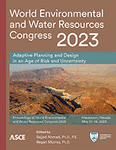Numerical Modeling of Embankment Failure due to Overtopping
Publication: World Environmental and Water Resources Congress 2023
ABSTRACT
Embankment failures can result in considerable property damage and fatalities. The most common cause of embankment failure is overtopping due to high water level in the river. The embankment failure process is complex because of rapid changes in flow and breach geometry. Accurate predictions of breach evolution help improving emergency preparedness and evacuation plans. In this work, a two-dimensional numerical model is developed and applied to simulate a real-life dam failure by overtopping during the historic October 2015 flood in South Carolina. The depth-averaged fluid mass and momentum conservation equations, known as shallow water equations, along with the sediment mass conservation equation are solved numerically. A unique feature of the model is the ability to simulate discrete slumping of breach sidewalls. The model captures the failure stages and estimates breach characteristics including breach dimensions and the breach hydrograph during the unsteady and steady phases of the failure. The comparison between model results and field observation shows a satisfactory agreement between the observed and simulated final breach-top width as well as the maximum eroded breach depth.
Get full access to this article
View all available purchase options and get full access to this chapter.
REFERENCES
Chaudhry, M. H. (2022). Open-channel flow. Third. New York: Springer Link.
Dupont, E., B. J. Dewals, P. Archambeau, S. Erpicum, and M. Pritton. (2007). “Experimental and numerical study of the breaching of an embankment dam.” In 32nd IAHR Biennial Congress-Harmonizing the demands from art and nature. Di Silvio, Giampolo.
Elalfy, E., A. A. Tabrizi, and M. H. Chaudhry. (2018). “Numerical and experimental modeling of levee breach including slumping failure of breach sides.” Journal of Hydraulic Engineering 144 (2): 04017066.
Faeh, R. (2007). “Numerical modeling of breach erosion of river embankments.” Journal of Hydraulic Engineering (ASCE) 133 (9): 1000–1009.
Kakinuma, T., and Y. Shimizu. (2014). “Large-scale experiment and numerical modeling of a riverine levee breach.” Journal of Hydraulic Engineering 140 (9): 4014039-1.
Leopardi, A., E. Oliveri, and M. Greco. (2003). “Numerical simulation of gradual earth-dam failure.” L’Acqua. 47–54.
MacCormack, R. W. (2003). “The effect of viscosity in hypervelocity impact cratering.” Journal of spacecraft and rockets 40 (5): 757–763.
Meyer-Peter, E., and R. Muller. (1948). “Formulas for bed-load transport.” In IAHSR 2nd meeting. Stockholm: IAHR.
Pontillo, M., L. Schmocker, M. Greco, and W. H. Hager. (2010). “1D numerical evaluation of dike erosion due to overtopping.” Journal of Hydraulic Research 48 (5): 573–582.
Sabbagh-Yazdi, S.-R., and M. Jamshidi. (2013). “Depth-averaged hydrodynamic model for gradual breaching of embankment dams attributable to overtopping considering suspended sediment transport.” Journal of Hydraulic Engineering (ASCE) 580–592.
Schmocker, L., and W. H. Hager. (2009). “Modelling dike breaching due to overtopping.” Journal of Hydraulic Research 47 (5): 585–597.
Schmocker, L., and W. H. Hager. (2012). “Plane dike-breach due to overtopping: Effects of sediment, dike height and discharge.” Journal of Hydraulic Research 50 (6): 576–586.
Spinewine, B., H. Capart, N. Le Grelle, S. Soares Frazao, and Y. Zech. (2002). “Experiments and computations of bankline retreat due to geomorphic dam-break floods.” In Proceedings of River flow. 651–661.
Tabrizi, A. A., E. Elalfy, M. Elkholy, M. H. Chaudhry, and J. Imran. (2017). “Effects of compaction on embankment breach due to overtopping.” Journal of Hydraulic Research 55 (2): 236–247.
Tabrizi, A. A., L. A. LaRocque, M. H. Chaudhry, E. Viparelli, and J. Imran. (2017). “Embankment failures during the historic October 2015 flood in South Carolina: Case study.” Journal of Hydraulic Engineering 143 (8): 05017001.
Talmon, A., N. Struiksma, and M. Van Mierlo. (1995). “Laboratory measurements of the direction of sediment transport on transverse alluvial-bed slopes.” Journal of hydraulic research 33 (4): 495–517.
Van Bendegom, L. (1947). “Eenige beschouwingen over riviermorphologie en rivierverbetering.” De Ingenieur.
Van Rijin, L. C. (1993). Principles of sediment transport in rivers, estuaries and coastal seas. Amsterdam: Aqua publications.
Visser, P. J. (1999). “Breach erosion in sand-dikes.” In Coastal Engineering 1998. 3516–3528.
Wu, W., Z. He, and S. S. Y. Wang. (2009). “A depth-averaged 2-D model of non-cohesive dam/levee breach processes.” In World Environmental and Water Resources Congress. Great Rivers. 1–10.
Information & Authors
Information
Published In
History
Published online: May 18, 2023
ASCE Technical Topics:
- Analysis (by type)
- Dam failures
- Disaster risk management
- Disasters and hazards
- Engineering fundamentals
- Failure analysis
- Failures (by type)
- Fluid mechanics
- Hydrologic engineering
- Man-made disasters
- Models (by type)
- Numerical models
- Simulation models
- Two-dimensional models
- Water and water resources
- Water conservation
- Water level
- Water management
- Water policy
- Water supply
- Wave overtopping
- Waves (fluid mechanics)
Authors
Metrics & Citations
Metrics
Citations
Download citation
If you have the appropriate software installed, you can download article citation data to the citation manager of your choice. Simply select your manager software from the list below and click Download.
